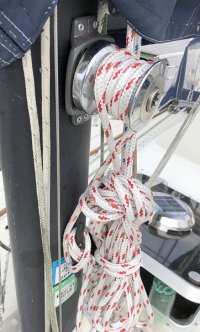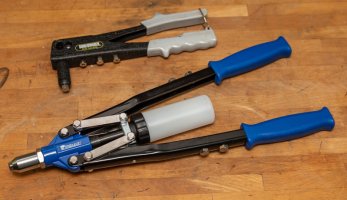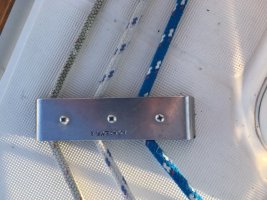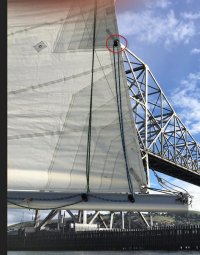Jib halyard moved.
I completed my work in moving the jib halyard, on the port side, out of the cockpit and back to the mast, since this line is rarely used. This opened a path for me to install a 1st reef downhaul through a block at the mast base, through the deck organizer and through the rope break in the cockpit making it easier and safer to reef while under sail. In the process I’ve learned a few things along the way, as is the case with most projects, so I’ll share it with you since that’s one of the main reasons for this forum.

I have a saying that I use, “
POE”, which stands for
Plan,
Organize,
Execute.
PLAN
So the planning for this project was fairly straight forward especially with info gathered from a few sources on this web site. My plan was simply to move the jib halyard to a new winch on the mast, add a cleat to tie off the line and then a first reef down haul line back to the cockpit using the same path that the halyard had used to the mast from the cockpit.
ORGANIZE
The organizing part took more time, of course. First I had to gather all the parts to relocate the halyard to the mast. I was fortunate to find a
single speed #8 Lewmar winch on eBay, for $65, that was in great shape and appeared to never been installed. From Defender I ordered a
Selden Winch Pad with a 5 degree rake (to prevent over wrapping) for $78 and from West Marine a
6” Nylon horn cleat for $3. On Amazon I bought a package of (30)
1/4-20 stainless steel rivet nuts for $8, the smallest amount I could find even though I really needed only two for the cleat. The Selden Winch Pad came with the five biggest pop rivets that I ever saw and I believe that they were stainless steel. They would require a 1/4” hole drilled into the mast to mount the pad. My “puny” little pop rivet gun just wasn’t up to the job and it didn’t have a head to fit the large pop rivets anyway so I found a
“Pittsburg” large, double handled pop rivet gun at my local Harbor Freight store that could handle the five large pop rivets that came with the winch pad. That cost me $20. Finally I had to find a rivet nut tool that cold handle the 1/4-20 stainless steel rivet nuts. After looking for the best deal I found an
“Astro Pneumatic Tool 1442 13" Hand Rivet Nut Setter” for $62 on Amazon. I did find a smaller tool at Harbor Freight that could handle 1/4-20 rivet nuts but only aluminum ones and not the the stainless steel kind because they were so much harder. I also ordered a small bag of 1/4-20 x 1/2 stainless steel flathead screws from Amazon for $12 to mount the winch to the winch pad.

Lewmar #8 Winch mounted to Selden winch pad

Double handled pop rivet next to my totally inadequate small pop gun.

Astro Pneumatic Tool 1442 to seat the 1/4-20 s/s rivet nuts
EXECUTE
The first thing was to drill and tap five 1/4-20 threaded holes into the winch pad that went without a hitch. Special care should be taken to drill the holes into the correct places on the Selden winch pad and that is info shown on the pad itself. Back on the boat I located the position of the winch pad and cleat then marking holes on blue tape I put over the areas. Then I used a punch on each point before drilling. Mounted the winch plate using the five pop rivets that came with it. Even with the large double handled pop rivet gun it was a bit of a strain to pop the rivets in but it’s not impossible. It just took more effort then I expected. The Astro Rivet Nut setter was another matter. I used it to seat the two 1/4-20 stainless steel rivet nuts in the mast for the cleat. When I used it I learned that I had to adjust the tool so that the handles were closer together, about a little more then half way between fully open and closed, because in the fully open position it was impossible to seat the stainless steel rivet nuts. One of the rivet nuts were malformed after I seated it, probably because of my inexperience even though I did practice with the tool at home, but I was able to use the same drill bit I used to make the original holes to drill the rivet out and do it again. Second time worked well. I highly recommend practicing with the rivet nut setting tool.
This past weekend, with winds gusting to over 20 knots I was able to reef the main from the cockpit so moving the jib halyard to the mast and adding a 1st reef downhaul has already paid off. I’m going to do the same thing for the 2nd second reef down haul on the starboard side by moving the spinnaker halyard to the mast and opening another path to the cockpit.
 I've not been able to locate any photos of a set up like I'm planning to do so any advice from someone who's done it would be helpful. (Christian?)
I've not been able to locate any photos of a set up like I'm planning to do so any advice from someone who's done it would be helpful. (Christian?) I've not been able to locate any photos of a set up like I'm planning to do so any advice from someone who's done it would be helpful. (Christian?)
I've not been able to locate any photos of a set up like I'm planning to do so any advice from someone who's done it would be helpful. (Christian?)








